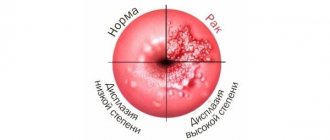Methods for cauterizing erosion
Treatment of cervical erosion is carried out using several cauterization techniques. How is the choice of treatment tactics made? The optimal treatment method is determined after a complete examination of the body, laboratory tests and additional diagnostic measures. In order to answer how cauterization is done, it is necessary to dwell on the basic treatment methods.
Main types of treatment:
- Diathermocoagulation is the effect on the affected areas of the mucous membrane through electric current.
- Laser vaporization – laser treatment.
- Cryodestruction - freezing erosion with liquid nitrogen.
- Radio wave or ultrasound treatment. (More details here)
- Argon plasma ablation is the effect of argon on the area of the mucosa affected by erosion.
- Mimic coagulation is the removal of erosion using certain medications or chemicals.
Each of these methods has its own advantages and disadvantages, so which type of cauterization will be most effective for each specific patient.
Important! Cauterization of cervical erosion also has some contraindications. Such procedures are not carried out during the period after childbirth and breastfeeding, in the presence of inflammatory processes in the genital organs or cancer.
A contraindication to diathermocoagulation is the absence of children. If erosion is cauterized by electric current, a rough scar may form, which in the future will significantly complicate the process of conception, bearing a child and childbirth.
Nitrogen treatment
Treatment is carried out with a special cryoprobe apparatus, which locally acts with a refrigerant (liquid nitrogen) on the damaged uterine mucosa and does not reach healthy tissue. In the process, in the cavity of the reproductive system, complete paralysis of the nerve endings occurs, which leads to loss of sensitivity for some time. Shock treatment of the affected area with low temperature (from -90 to -180⁰С) promotes rapid vasoconstriction, preventing the release of blood.
Method
Cauterization with nitrogen
is the freezing of intracellular fluid by the tip of the apparatus, resulting in the destruction of the cell membrane and all elements of papillomavirus infection.
The procedure is one-time and is prescribed on days 7–10 of the menstrual cycle. The first manifestations of tissue restoration occur from the second week, complete replacement occurs after 3 months.
Causes and signs of endometrial hyperplasia, treatment with folk and traditional methods
Tests before cauterization of cervical erosion
Before the cauterization procedure, the patient is examined and tests are taken to determine the type, size and stage of the erosive process. Already during the gynecological examination, the doctor will be able to diagnose the presence of erosive lesions of the vaginal mucosa.
Laboratory tests are required. This is a smear to determine the vaginal microflora, a PCR test to detect sexually transmitted diseases, a general clinical and biochemical blood test.
During the diagnostic process, the doctor conducts a histological examination of tissues affected by erosion, and tests for HIV and hepatitis. If all tests are normal, the woman is asked to undergo cauterization of cervical erosion. If inflammation or other disease is detected, it is first treated.
General information about the disease
Cervical erosion
Uterine erosion is a common pathology in gynecology, resulting in damage to the mucous membrane.
There are several types: congenital, when the wound is formed due to a failure or restructuring of hormones; true - a small defect in the mucous membrane that heals quickly without treatment; false - the most dangerous, in which the epithelium cannot heal without the help of medications. This type is the most common, but modern technologies and methods make it possible to get rid of it in a matter of days, including liquid nitrogen.
Recovery after cauterization of cervical erosion
After cauterization of the erosive area of the mucosa, healing of the cervix begins, which, depending on the type of intervention, can last from 3 to 8 weeks. What to do during this period in order to speed up the restoration of damaged mucous tissues? It is very important to strictly follow all the recommendations of your attending physician, who will tell you what restrictions cervical erosion requires after cauterization.
Many women who have been diagnosed with this gynecological disease have a question: does the scar remain on the cervix and what does such a scar look like in the photo? Experts are sure that it all depends on how exactly the erosive lesion of the uterine cervix was treated.
In some cases, after treatment, adhesions and scars may form on the cervical canal, which cause a significant narrowing of the uterine cervix. As a result, this can lead to serious problems with conceiving and bearing a child.
Cauterization with laser and radio waves is considered the safest and most gentle, since after their use no wounds or deformations appear on the vaginal mucosa. Complications occur extremely rarely, and the recovery period takes no more than 1-1.5 months.
What happens after diathermocoagulation? Treatment of an erosive area with electric current is characterized by the appearance of a so-called scab. During the procedure, an electric current “removes” erosive lesions from the mucous membrane, in place of which a scab appears that covers the bleeding wound. The scab comes off on its own in about 2 weeks.
Cryodestruction technique
The operation takes no more than 30 minutes. To clearly see the boundaries of the affected part, the doctor treats the area of the cervix with Lugol's solution or a weak solution of acetic acid. After determining the size of the affected area, an applicator of the required diameter is selected. It will be used to freeze the diseased epithelium.
The cryotherapy apparatus is filled with liquid nitrogen. Liquefied gas flows through the conductor to the applicator. The applicator is applied to the affected tissue. The time for supplying liquid nitrogen is recorded. Cauterization continues for 5 minutes, then the flow of nitrogen stops. The applicator freezes and can be easily removed from the cervix. Frozen epithelium turns from white to red as it warms up.
Oncologists recommend repeating this procedure after thawing the cervix for another 5 minutes.
For faster thawing, some experts recommend irrigating the applicator with water or an isotonic solution. However, the point of cauterization is to withstand the freezing time. The longer the applicator is exposed to the affected tissue, the deeper the freezing will occur.
If the affected part is larger than the diameter of the applicator, then it can be moved to the sides to completely cover the diseased epithelium.
After any other method of cauterization of the cervix, a tampon with an antiseptic is inserted into the vagina. Cryodestruction does not require this.
Within an hour, lymphorrhea appears - this is the leakage of lymph as a result of damage to the lymphatic vessels during surgery. The intensity of lymphorrhea depends on the area of damaged tissue on the cervix and the caliber of the lymphatic vessels.
For a better understanding of cryodestruction of the cervix, we systematize the order of work:
- Treatment of the neck with Lugol's solution or acetic acid.
- Freezing with liquid nitrogen (5 min.).
- Defrost the applicator and neck (10 min.).
- Repeated freezing of the affected area (5 min.)
- Repeated freezing of the applicator and cervix (10 min).
Pain in the lower abdomen during cryogenic treatment and immediately after it is associated with hypothermia of part of the cervix. Its intensity is not strong, its character is aching, pulling. The pain goes away quickly, on its own.
Vaporization is a modern and painless method of treatment in gynecology
Consequences of cauterization of cervical erosion
Despite the fact that moxibustion is considered an effective and modern procedure, it can also have certain consequences for the female body.
- Scarring of the uterine cervix.
- Disruption of the normal menstrual cycle.
- Inflammation of the fallopian tube or ovaries.
- Recurrent development of cervical erosion.
- Heavy bleeding.
- Cervical canal stenosis.
Important! If we talk about such consequences as minor vaginal discharge or aching, nagging pain in the lower abdomen, itching, then they are not considered complications. Also, during the recovery process, your body temperature may increase. This is a normal phenomenon that often accompanies the healing process of the vaginal mucosa. As a rule, such phenomena disappear on their own 2-8 weeks after cauterization.
For 7-8 weeks after treatment, the woman is advised to give up bad habits and eat right. Alcohol and nicotine can dilate blood vessels, which can lead to increased bleeding and a longer recovery period.
Restrictions during the recovery period after cauterization
What should not be done during the recovery period after erosion of the uterine cervix?
It is worth noting that healing of the vaginal mucosa is a simple process, but requires strict adherence to all medical recommendations. Women need to remember that sports and fitness are prohibited at this time. Any physical activity or heavy lifting is also strictly prohibited. The maximum permissible weight that can be lifted is no more than 3 kg.
When it comes to feminine hygiene products, you should never use tampons, only pads.
For hygiene measures, it is best to take a warm shower; it is best to avoid a hot bath. Also, for 4-6 weeks you must avoid visiting a bathhouse, sauna, jacuzzi, or public pool. Women who have undergone treatment for cervical erosion should forget about swimming in open water for 4-6 weeks.
Cervical erosion after cauterization requires extremely careful attention. You can return to sexual activity only after a certain period of time, when the affected area of the mucous tissue is completely restored.
Important! Sex is allowed only 4-8 weeks after medical intervention. Before returning to intimate relationships, you must undergo a gynecological examination and obtain permission from a doctor to return to sexual relations.
Preparation for cryodestruction and postoperative period
Preparation for the minimally invasive procedure takes place in a medical facility and does not take much time. The following steps must be performed first:
- examination by a gynecologist
- testing for sexually transmitted infections
- colposcopy
The moral preparation of the patient for such a procedure is important. Only an optimistic attitude will make the treatment of erosion invisible.
After cauterization of erosion, it is not recommended to swim in open water or public pools for 3 months. Sports should be changed to warm-up, without putting much stress on the reproductive organ. You should also avoid sex for a month, since the necrosis zone is an open wound.
Pregnancy and childbirth after cauterization of cervical erosion
Is it possible to give birth after cauterization of cervical erosion? This question arises for every woman who is planning to expand her family in the future. Gynecological disease is not an obstacle to successful pregnancy.
But childbirth must take place at least a year after treatment. Accordingly, pregnancy should be planned no earlier than 2-3 months after medical intervention.
If a woman plans to become a mother soon, she should pay special attention to the choice of treatment method for cervical erosion, since not all methods are suitable for nulliparous patients.
The optimal method of treatment is laser exposure, as well as radio wave treatment. Diathermocoagulation should be abandoned, since after removing erosion with electric current, rough scars and deformations may appear on the surface of the vaginal mucosa, which in the future will become a serious problem on the path to motherhood.
Today, effective, safe and gentle techniques are used to treat gynecological diseases. Many women are concerned about how childbirth will go after treatment for erosive lesions of the cervix.
As a result of a laser or other modern procedure, erosive lesions are removed as carefully as possible, healthy tissue is not damaged, and scars and deformations do not form. As a result, the woman gives birth without any special changes.
The concept of cryotherapy and the mechanism of action of liquid nitrogen
Cryotherapy is a method of treating and preventing diseases through cold. The general effect is aimed at the response of skin receptors to hypothermia. It is based on cooling the human skin with cold gas (nitrogen), as a result of which a spasm of the skin vessels occurs, and then their reflex expansion and increased blood flow to the internal organs. After the procedure is completed, metabolism and oxygen flow in the skin and subcutaneous tissue increase, actively influencing the breakdown of adipose tissue and reducing the appearance of cellulite. The systematic effect of low temperatures on the body helps to increase the body's reactivity and protective functions.
Local application of cryotherapy is also called cryodestruction; it is used to remove pathological or cosmetic defects. The method is based on the use of liquid nitrogen in a pathological focus in order to lower its temperature to -80°C. Under its influence, the liquid contained in the cell freezes, the integrity of the membrane is disrupted and the cellular structure is destroyed. The circulation of substances in the cells of the pathological focus stops, it dies.
From the moment of exposure to epithelialization by new tissue, nitrogen therapy goes through several stages:
- Freezing tissue of the pathological focus.
- Formation of effusion in tissues (edema), due to a significant increase in blood flow.
- In the next two days after the procedure, the differentiation of the frozen area from the healthy one begins.
- After two weeks, necrotic tissue is rejected, active regeneration occurs with the formation of granulations and new epithelium.
- At 4-8 weeks, the epithelization process ends.









